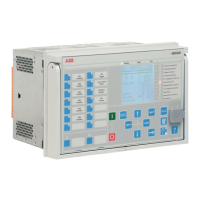the operation characteristics. When an internal fault occurs, the currents on both
sides of the protected object are flowing into it. This causes the biasing current to
be considerably smaller, which makes the operation more sensitive during internal
faults.
The traditional way for calculating the stabilized current is:
(Equation 59)
The module calculates the bias current for all three phases.
Through-fault detection
Through-fault (TF) detection module is for detecting whether the fault is external,
that is, going through, or internal. This information is essential for ensuring the
correct operation of the protection in case of the CT saturation.
• In a through-fault situation, CTs can saturate because of a high fault current
magnitude. Such AC saturation does not happen immediately when the fault
begins. Thus, the TF module sees the fault as external because the bias current is
high but the differential current remains low. If the AC saturation then occurs, a
CT saturation-based blocking is allowed to work to prevent tripping.
• Normally, the phase angle between the machine neutral and line side CTs is 180
degrees. If an internal fault occurs during a through fault, an angle less than 50
degrees clearly indicates an internal fault and the TF module overrules, that is,
deblocks the presence of any blocking due to CT saturation.
CT saturation-based blocking
Higher currents during the motor startup or abnormally high magnetizing currents
at an overvoltage (transformer-fed motor) or an external fault may saturate the
current transformers. The uneven saturation of the star and line side CTs (for
example, due to burden differences) may lead to a differential current which can
cause a differential protection to operate. This module blocks the operation of
MPDIF biased low stage internally in case of the CT saturation. Once the blocking is
activated, it is held for a certain time after the blocking conditions have ceased to
be fulfilled.
DC component detection
On detection of a DC component, the function temporarily desensitizes the
differential protection. The functioning of this module depends on the
DC restrain
Enable
setting. The DC components are continuously extracted from the three
instantaneous differential currents. The highest DC component of all three is taken
as a kind of DC restraint in a sense that the highest effective, temporary sensitivity
of the protection is temporarily decreased as a function of this highest DC offset.
The calculated DC restraint current is not allowed to decay (from its highest ever
measured value) faster than with a time constant of one second. The value of the
temporarily effective sensitivity limit is limited upwards to the rated current of the
machine or 3.3 times that of
Low operate value
, whichever is smaller. The temporary
extra limit decays exponentially from its maximum value with a time constant of
one second.
This feature should be used in case of networks where very long time constants
are expected. The temporary sensitivity limit is higher to the set operating
Protection functions
1MRS757644 H
504 620 series
Technical Manual

